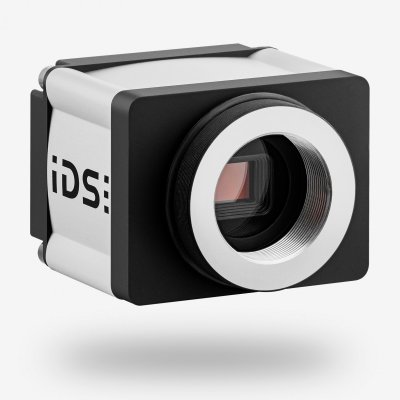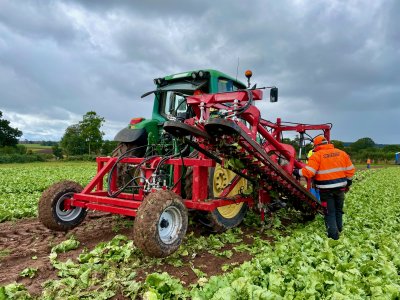The lettuce’s outer, or ‘wrapper’, leaves will be mechanically removed to expose the stem. Machine vision and artificial intelligence are then used to identify a precise cut point on the stem to neatly separate the head of lettuce.
 Robot Solution for Automating the Lettuce Harvest
Robot Solution for Automating the Lettuce Harvest

Case Study from | IDS Imaging Development Systems
Lettuce is a valuable crop in Europe and the USA. But labor shortages make it difficult to harvest this valuable field vegetable, as sourcing sufficient seasonal labor to meet harvesting commitments is one of the sector's biggest challenges. Moreover, with wage inflation rising faster than producer prices, margins are very tight. In England, agricultural technology and machinery experts are working with IDS Imaging Development Systems GmbH (Obersulm, Germany) to develop a robotic solution to automate lettuce harvesting. The team is working on a project funded by Innovate UK and includes experts from the Grimme agricultural machinery factory, the Agri-EPI Centre (Edinburgh UK), Harper Adams University (Newport UK), the Centre for Machine Vision at the University of the West of England (Bristol) and two of the UK's largest salad producers, G's Fresh and PDM Produce.
Within the project, existing leek harvesting machinery is adapted to lift the lettuce clear from the ground and grip it in between pinch belts. The lettuce’s outer, or ‘wrapper’, leaves will be mechanically removed to expose the stem. Machine vision and artificial intelligence are then used to identify a precise cut point on the stem to neatly separate the head of lettuce.
"The cutting process of an iceberg is the most technically complicated step in the process to automate, according to teammates from G subsidiary Salad Harvesting Services Ltd.," explains IDS Product Sales Specialist Rob Webb. "The prototype harvesting robot being built incorporates a GigE Vision camera from the uEye FA family. It is considered to be particularly robust and is therefore ideally suited to demanding environments. "As this is an outdoor application, a housing with IP65/67 protection is required here," Rob Webb points out.
The choice fell on the GV-5280FA-C-HQ model with the compact 2/3" global shutter CMOS sensor IMX264 from Sony.
 "The sensor was chosen mainly because of its versatility. We don't need full resolution for AI processing, so sensitivity can be increased by binning. The larger sensor format means that wide-angle optics are not needed either," Rob Webb summarized the requirements. In the application, the CMOS sensor convinces with excellent image quality, light sensitivity and exceptionally high dynamic range and delivers almost noise-free, very high-contrast 5 MP images in 5:4 format at 22 fps - even in applications with fluctuating light conditions.
"The sensor was chosen mainly because of its versatility. We don't need full resolution for AI processing, so sensitivity can be increased by binning. The larger sensor format means that wide-angle optics are not needed either," Rob Webb summarized the requirements. In the application, the CMOS sensor convinces with excellent image quality, light sensitivity and exceptionally high dynamic range and delivers almost noise-free, very high-contrast 5 MP images in 5:4 format at 22 fps - even in applications with fluctuating light conditions.
The extensive range of accessories, such as lens tubes and trailing cables, is just as tough as the camera housing and the screwable connectors (8-pin M12 connector with X-coding and 8-pin Binder connector). Another advantage: camera-internal functions such as pixel pre-processing, LUT or gamma reduce the required computer power to a minimum.
The prototype of the robotic mower will be used for field trials in England towards the end of the 2021 season. "We are delighted to be involved in the project and look forward to seeing the results. We are convinced of its potential to automate and increase the efficiency of the lettuce harvest, not only in terms of compensating for the lack of seasonal workers,” affirms Jan Hartmann, Managing Director of IDS Imaging Development Systems GmbH.

Figure: Prototype lettuce harvesting robot of Agri-Epicentre (UK)
The challenges facing the agricultural sector are indeed complex. According to a forecast by the United Nations Food and Agriculture Organisation (FAO), agricultural productivity will have to increase by almost 50 percent by 2050 compared to 2012 due to the dramatic increase in population. Such a yield expectation means an enormous challenge for the agricultural industry, which is still in its infancy in terms of digitalization compared to other sectors and is already under high pressure to innovate in view of climatic changes and labor shortages.
The agriculture of the future is based on networked devices and automation. Cameras are an important building block, and artificial intelligence is a central technology here. Smart applications such as harvesting robots can make a significant contribution to this.

The content & opinions in this article are the author’s and do not necessarily represent the views of ManufacturingTomorrow
Comments (0)
This post does not have any comments. Be the first to leave a comment below.
Featured Product

